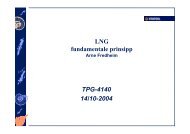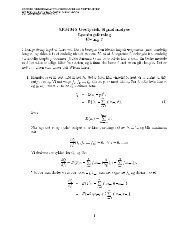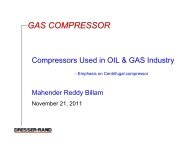- Page 1 and 2:
1 ci 0 Ilc (i) s_ri P4 4) •,-1 0
- Page 3 and 4:
ACKC’bJLED3E.:ENTS should like to
- Page 5 and 6:
46 iixperimental Results 461 IntroJ
- Page 7 and 8:
APPNNDICES 1. PHYSICal PRSPHTIES Oi
- Page 9 and 10:
the major unresolved problem in hea
- Page 11 and 12:
and time, fouling factors are usual
- Page 13 and 14:
o F-I 0 U J ,ij cn J ‘I—I F3 Fl
- Page 15 and 16:
—5— vary from less than 1 per c
- Page 17 and 18:
2.2.3 Solubility refined paraffin w
- Page 19 and 20:
-.9— whica is well novc condition
- Page 21 and 22:
— -ii — deposit. Tronov statej
- Page 23 and 24:
— 13 remain in solution and the p
- Page 25 and 26:
- iuctoov and dorov concluded hat t
- Page 27 and 28:
— 17 — a deporsiion ce:Ll in a
- Page 29 and 30:
— 19 - toat sur:ace. hjsima.a ot
- Page 31 and 32:
— 2 - S * .. -, ‘.: ,- - .-,-
- Page 33 and 34:
and surface proueriez reapectlvely_
- Page 35 and 36:
- 25 - loading to a random process
- Page 37 and 38:
y - F’J CD:’ C) x— Dcpoit thi
- Page 39 and 40:
0 C 15O— 200 From ref 2 of wax eo
- Page 41 and 42:
0 o3 Tb 3D 0•0 L D 2 •O— Fg.2
- Page 43 and 44:
2 I In 0 Tot -D -D U 16H 16 20, In
- Page 45 and 46:
C CE) CL) CE) () .: rJ\: - . c: CD
- Page 47 and 48:
400 function of roughness factor. m
- Page 49 and 50:
— 2o — 3. i3:\CGRDU ND TO TI PR
- Page 51 and 52:
3.5 Conclusions decreases At the in
- Page 53 and 54:
L - A sz: CF Fo:;:NG BY SOLUTIONS O
- Page 55 and 56:
was designed to cut off the steam s
- Page 57 and 58:
• saLLy measures were tacen. oa:D
- Page 59 and 60:
— 34 .4 ‘mrii:ntal Solution The
- Page 61 and 62:
sections were ke-:t the same. fosi:
- Page 63 and 64:
sectaon 4- at eajt tests sections h
- Page 65 and 66:
These fluctuations were not reduced
- Page 67 and 68:
ii ID XXX 9 C-) 0 (N x S x xx< 7r-
- Page 69 and 70:
12— -; 11L. s 10E - 9: ‘3) 0 Ru
- Page 71 and 72:
(1) U) C’) C) Cl) It) 0 0 0 0 ox
- Page 73 and 74:
f-iq. 1.0-3.5.— Hecit trcinsfcr r
- Page 75 and 76:
I--i Fig. f.6.3.7. I ;ut transfer r
- Page 77 and 78:
0 C’) R — [feat transfer resist
- Page 79 and 80:
characteristc does exist and is tyt
- Page 81 and 82:
The ziuewor in the circulation syst
- Page 83 and 84:
The calibrations o the tesperature
- Page 85 and 86:
the solution and water o::a;es thro
- Page 87 and 88:
‘-- 5,5 wocrinentsl Resuts with f
- Page 89 and 90: two hours, the deposits were observ
- Page 91 and 92: wcr: on ara:zic: c.eposc.tion consi
- Page 93 and 94: -- II 1 L1 SOLUIIOIJ C;IFCU1_/:[ION
- Page 95 and 96: SCAR FE 1 DEPOSITION PLATE - - 0 C)
- Page 97 and 98: M—AMOUNI DEPOSITED (mg) T1 0_i c)
- Page 99 and 100: C) 0 0 0 Li.] CD - 3 0 3 0 h Iii (E
- Page 101 and 102: - II -fl M—AMOUNT DEPOSITED (rng)
- Page 103 and 104: 91 9) :< C) --z 9] mc-) .;J -i ru
- Page 105 and 106: .1 1• ci E 0 Ci) c) — nj
- Page 107 and 108: - . O, O, I— —,-, fouling studi
- Page 109 and 110: profiles at different Reynolds numb
- Page 111 and 112: L Run . (°c) used to calculate tem
- Page 113 and 114: Due to a concentration gradient the
- Page 115 and 116: 1 I C. (1.2.2.2 \1L. I .OC[FY V [A[
- Page 117 and 118: V 40 - 0 C—, lt! -— o. ---—-
- Page 119 and 120: Li FIG. G.2.3./. TEMPERAI URE v RAD
- Page 121 and 122: — 1 7.0 0 --Tc.=10.0°C 50 140
- Page 123 and 124: — -- — -——— — -—Tb =
- Page 125 and 126: Z_o_—o-- 50 l0 - yX—--X— —-
- Page 127 and 128: I:302 00 50 Ito -0——— ---—-
- Page 129 and 130: I 50 ;) 30c’/ / C —------------
- Page 131 and 132: FIG. 6. 4.1. AN IDEEAL TEMPERATURE
- Page 133 and 134: — 63 — 7. DISCUSSIOI 7.1 Introd
- Page 135 and 136: — 65 — through it decreases gra
- Page 137 and 138: For breakdown and removal to occur
- Page 139: — 69 — the large fouling studie
- Page 143: — 72 — 8. ICOi’NDATTCNS It is
- Page 146 and 147: EEfiDN2WON
- Page 148 and 149: T TemDerature T = Average temperatu
- Page 150 and 151: = :ieat eddy dfusivity = Xoent eddy
- Page 152 and 153: in Exchar.ge: Tubes”, Chem. Engr.
- Page 154 and 155: Oil Gas J., 58 (38), 87—91 (Sept.
- Page 156 and 157: U U F--I C) (f
- Page 158 and 159: The o1ubi1ity of 5i/54°Cparafin wa
- Page 160 and 161: — — .‘.ti+ c:Lic gravity The
- Page 162 and 163: In section Al .4 the auount of pcra
- Page 164 and 165: 0 •) X S (N U ‘0 -° CD c-) ( -
- Page 166 and 167: I-] H — C C) p 0’ H 0’ H CD C
- Page 168 and 169: fully refined paraffin wax in keros
- Page 170 and 171: — A12 — The cloud point decrens
- Page 172 and 173: — A3 — Tnble A2.1 Ca1culccd c i
- Page 174 and 175: calibration constants are given in
- Page 176 and 177: — Al? — Table A3.3.1 Calibratio
- Page 178 and 179: — A19 — APPENDIX 4 THE PRDGR’
- Page 180 and 181: C NC = C C REiCS EACH SET OF RE[iJC
- Page 182 and 183: 13.42 7.40 7.SC 33.90 33.10 13.8 0.
- Page 184 and 185: TIME TI TO TKI TKC DPK EPW DPT V CF
- Page 186 and 187: 81.15 7.45 7.7C 33.40 32.70 30.0 0.
- Page 188 and 189: RUN A1C—4 TIME 1WI TWO TKI TKC DP
- Page 190 and 191:
RUN 82—6 TIME TiI TC TKI TKC OPK
- Page 192 and 193:
TIME TWI TWO TKI TKC OPK CPW OPT V
- Page 194 and 195:
RUN B7—1C TIME TWI TWC TKI TKO DP
- Page 196 and 197:
RUN B9—12 T V’E ThI TWC TKI TKC
- Page 198 and 199:
RUN C1—1t T1’E IWI TWO TKI TKC
- Page 200 and 201:
PUN C2—15 TIME T’iI T0 TK1 TKC
- Page 202 and 203:
}U•” C-16 TIME TWI TWO TKI TKC
- Page 204 and 205:
TIME flit TC TKI TKO DPK DPW OPT V
- Page 206 and 207:
UN C5-18 TIME TWI TfD TKI TKO DPK C
- Page 208 and 209:
14.25 7.IC 10.2C 39.10 38.00 8.8 0.
- Page 210 and 211:
RUNJ C8-2C T[’E TWE T0 TKI (Hg) (
- Page 212 and 213:
TIVE M)*2 C) TWI TWO TKI TKC DPK op
- Page 214 and 215:
Tt’iE TWI TC TKI TKO OPK CPW DPT
- Page 216 and 217:
— A23 — APPENDIX 5 OALT2RATTUNS
- Page 218 and 219:
T—- TEI\iFERATUFE (°C) —I’ U
- Page 220 and 221:
d Average C Table A5.2 0.0452 0.025
- Page 222 and 223:
11.1 6.517 10.5 6.418 10.1 6.346 9.
- Page 224 and 225:
— A27 — Tib1e A6.2 Pun Dl .irn
- Page 226 and 227:
-A29- Table A6.4 Pun 1)3 ‘ Time (
- Page 228 and 229:
Time — A51 — Table A6.5 Run D5
- Page 230 and 231:
— A33 — APPENDIX 7 EOUNDARY LAY
- Page 232 and 233:
— ;55 — 1.7.3 Dimensionless Exp
- Page 234 and 235:
— = u — u = in — + ± + + or
- Page 236 and 237:
I A8.21 Data 2 Subroutines usng ite
- Page 238 and 239:
— ALf1 — Equations L.7.4.3 and
- Page 240 and 241:
— A1i•3 — Lt Prorran Use The
- Page 242 and 243:
DIM /\3.2./>. THE iJNI/E?j\I. \ELC)
- Page 244 and 245:
C DF1ENSIOH VIS(2.) REAL NUWSI INTE
- Page 246 and 247:
C C SUt3ROUTINE DATA INTEGER SR C C
- Page 248 and 249:
LI) I Li . 0 0 X .. (1•) U.. UI
- Page 250 and 251:
C C WRt 1E(6,’O) 60 FQR’AT(1HLf
- Page 252 and 253:
te 4Z’Xt’9’911’XZ’ 3DNVIS
- Page 254 and 255:
C C C C C )fl:O .0 DO ‘O 1=3,9,2
- Page 256 and 257:
C, .4:’. 0 0 —; —s iZ fl r;
- Page 258 and 259:
KINEMATIC VISCOSITY AT WALL 0.07407
- Page 260 and 261:
YP UP TP Y U T VIS TC CR PR 39.00 1
















